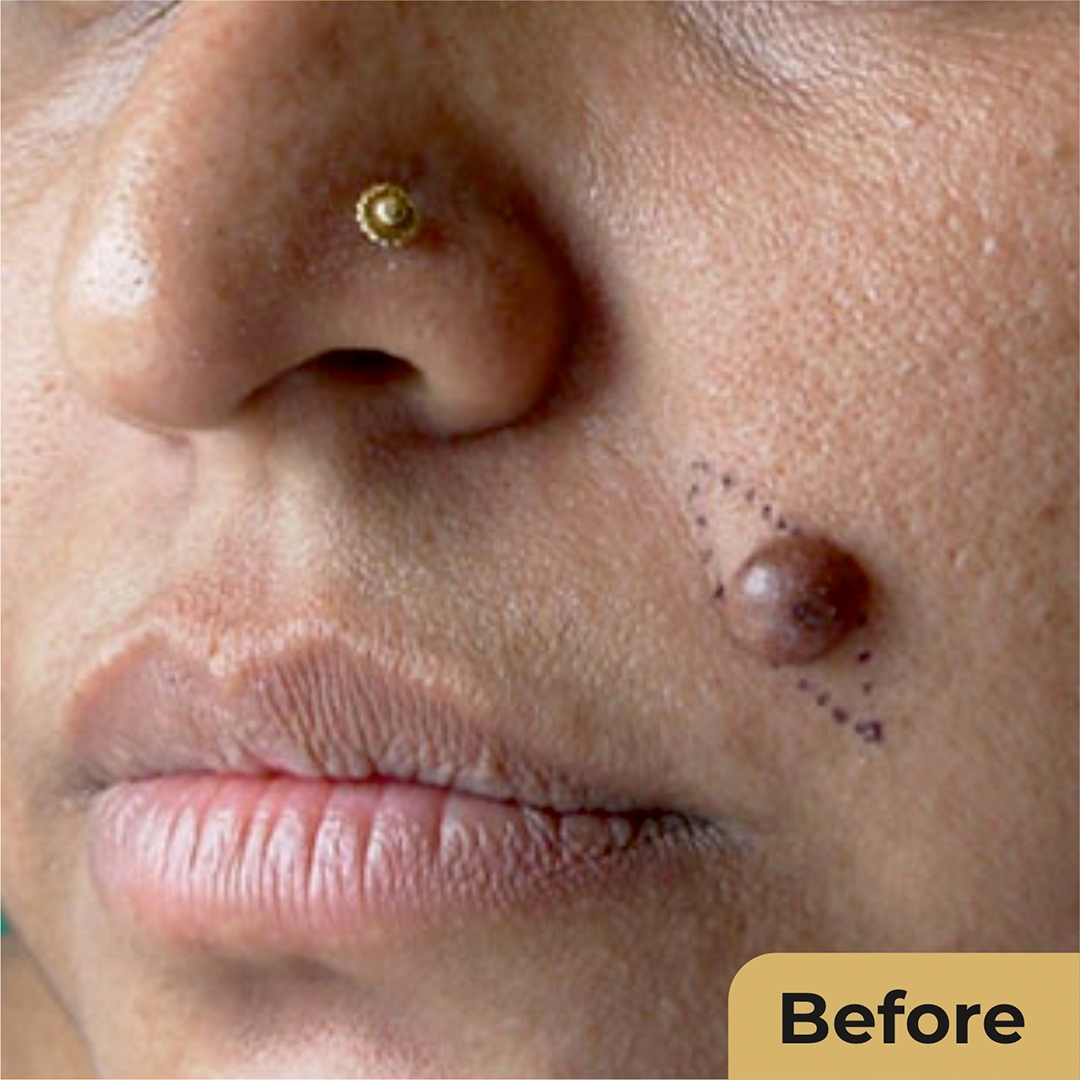
Wart Tag Removal Treatment in Vadodara

Mole, wart, and tag removal treatment is a non-invasive or minimally invasive procedure used to eliminate unwanted skin growths. At Krisha Hospital, we specialize in laser mole removal in Vadodara, offering quick, effective solutions with minimal discomfort. This treatment is ideal for cosmetic enhancement and preventing irritation caused by skin tags or warts.
Opting for mole, wart, and tag removal in Vadodara helps enhance your skin’s appearance, prevent clothing friction, and reduce potential infection risks. Krisha Hospital—the best wart removal clinic in Gujarat—uses advanced technology to ensure painless wart removal near you, with a high success rate and minimal downtime.
Mole, wart, and tag removal treatment is considered the best choice for achieving smooth, blemish-free skin because it offers a safe, effective, and minimally invasive solution for unwanted skin growths. Using advanced methods like laser mole removal, this treatment precisely targets the affected areas without damaging the surrounding skin.
It is suitable for both men and women and ensures minimal pain, low risk of scarring, and fast recovery time. Whether for cosmetic enhancement or medical reasons, this treatment provides visible before-and-after results, making it a top solution for skin clarity and confidence restoration.
Before undergoing laser mole removal in Vadodara, patients should:
- Avoid sun exposure for at least one week.
- Discontinue using skincare products containing retinol, AHAs/BHAs, or steroids.
- Inform the doctor about any medications or allergies.
- Clean the treatment area thoroughly and avoid applying makeup or lotions.
- Schedule a tag removal consultation in Vadodara to assess skin type and growth condition.
During the pre-surgery stage at Krisha Hospital, our experts perform:
- A detailed skin examination and consultation.
- Photographs for before-and-after comparisons.
- Skin sensitivity tests, if needed.
- A consent process where the entire treatment plan, side effects, and recovery expectations are explained.
- Application of topical anesthesia (if laser removal is used) for a painless experience.
- Protect the skin from sun exposure using sunscreen or covered clothing. Keep the area clean and dry for the first 24–48 hours.
- Apply prescribed ointments or antibiotic creams as advised by your dermatologist.
- Avoid scratching, picking, or rubbing the treated area.
- Do not apply makeup or harsh skincare products on the treated area until fully healed.
- Attend any follow-up appointments if scheduled.
Healing generally takes 5–10 days, depending on the area and size of the removed lesion.
While the procedure is generally safe, a few temporary side effects may occur:
- Mild redness, swelling, or tenderness around the treated area
- Scabbing or slight peeling during the healing process
- Temporary discoloration or changes in skin pigmentation
- Minimal risk of infection if aftercare isn’t followed properly
- Very rare chance of scarring, especially if the lesion was deep


EXCELLENTTrustindex verifies that the original source of the review is Google. Krisha hospital ma me brest size mate consulting karyu d .r rajnikant sir jode Mane ghanu saru samjavyu chhe thanks sirPosted onTrustindex verifies that the original source of the review is Google. Me krisha hospital ma hair fall ni treatment lidhi chhe mane ghanu saru result madiyu chhe thanks for krisha hospitalPosted onTrustindex verifies that the original source of the review is Google. Very nice Krisha Hoshpital na all's Sister and Doctor Rajanikant parmar aap shau a mane bahuj sharsh halp Sarwish aapi mane Pahela karta atiyare bahuj sharu fil thay che Thank u so much doctor &shatap Shalam che tamne Doctor Rajanikant shahenPosted onTrustindex verifies that the original source of the review is Google. Really happy with service. One of the best clinicPosted onTrustindex verifies that the original source of the review is Google. Amazing worked on my face by rajnikant sir.. I have many stitches on my face but after recovery no marks on my face.. Thank you very much..Posted onTrustindex verifies that the original source of the review is Google. Krisha hospital me mene skin glow ke liye haydra facial karvaya tha nice result Thanks sir & staffPosted onTrustindex verifies that the original source of the review is Google. All cosmatic surgerys are excellent specially Hair Transplant & Tummy TuckPosted onTrustindex verifies that the original source of the review is Google. Mene Hair Transplant Surgery Karvai he or mujhe bohot excellent result Mila he or me or bhi loggo prefere karunga So thank uuu krisha hospitalPosted onTrustindex verifies that the original source of the review is Google. Best Hair Transplant & Hair Loss Surgery In Vadodara City
At Krisha Hospital, mole removal in Vadodara is typically performed using advanced laser technology. The laser targets and breaks down the pigment in the mole or destroys the tissue safely, offering precise removal with minimal discomfort and scarring.
Krisha Hospital is regarded as the best wart removal clinic in Gujarat due to its skilled dermatologists, advanced equipment, painless treatments, and excellent patient care with high success rates.
The tag removal cost in Vadodara depends on the size, number, and method of removal (laser or excision). At Krisha Hospital, the prices are affordable and transparent, with customized consultation available.
Yes, the treatment is highly effective and suitable for both men and women, regardless of age or skin type, especially for cosmetic concerns or irritation caused by skin growths.
Yes, before-and-after results are available at Krisha Hospital to help patients visualize the outcomes of mole removal and make informed decisions.
You can find expert mole removal near me at Krisha Hospital, located centrally in Vadodara, offering top-rated cosmetic skin treatments.
The mole removal recovery time is usually 5 to 10 days. Patients can return to normal activities quickly, with minimal aftercare and very low risk of complications.
Wart removal side effects may include slight redness, scabbing, mild pain, or temporary pigmentation. These effects are rare and typically subside within a few days with proper care.
To schedule a tag removal consultation in Vadodara, simply call Krisha Hospital or book online through the website.
Krisha Hospital boasts a high success rate in mole removal treatments, with precise procedures, minimal scarring, and excellent patient satisfaction.
Yes, laser mole removal in Vadodara is available at Krisha Hospital. The treatment is fast, safe, and offers aesthetically pleasing results with little to no downtime.

